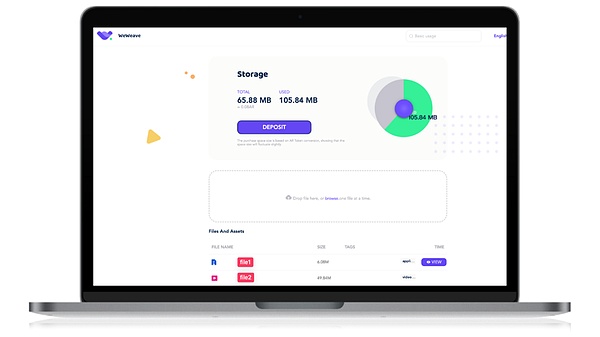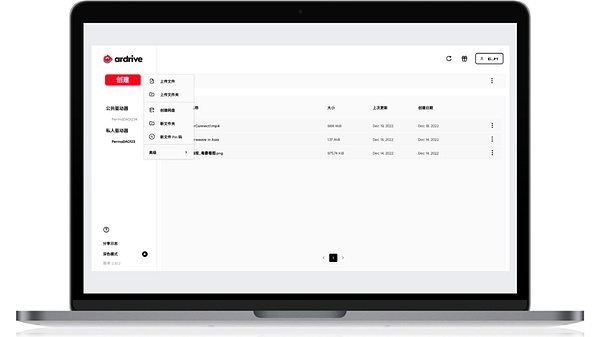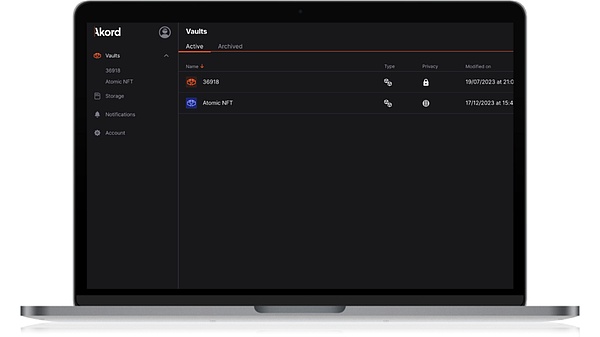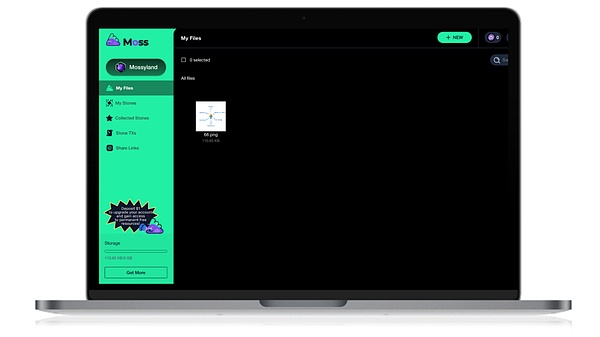Author: Kyle, PermaDAO
With the explosion of the DePIN concept, the decentralized storage track has once again attracted widespread attention in the market. Decentralized storage is an important infrastructure in the Web3 field, but for ordinary users, it may be difficult to intuitively appreciate its charm. However, network disk products have always been one of the best choices for the general public to appreciate storage services.
Xdrive, the earliest network disk project on the traditional Internet, was born in 2002, and Google Drive, the most popular network disk today, has been launched for nearly 12 years and has more than 3 billion users. Network disk products have already reached thousands of people’s homes, but at the same time, data loss or theft continues to occur in the real world due to centralized network disks. Data has gradually become an important asset for people, and decentralized storage is becoming the new guardian of private property. Among the many decentralized storage solutions, people often see FIL with a higher market value first, and the author wants to explore the more unique Arweave and its ecological network disk project.
Arweave has been running smoothly for nearly 6 years since its mainnet was launched in 2018. It is designed for permanent storage and has a unique Blockweave's data structure, Simple and elegant SPoRA consensus mechanism and Mature economic incentive mechanism. At the same time, Arweave also launched a native smart contract standard - SmartWeave, allowing developers to develop applications on it. In addition, Arweave is an open protocol that supports any application integration to achieve permanent storage functionality.
At the beginning of 2024, according to incomplete statistics, there have been more than 130 projects built around Arweave, which can be subdivided into 12 tracks. Arweave is already a large and active ecosystem. This article will focus on the network disk projects in the Arweave ecosystem - WeWeave, ArDrive, Akord and Moss, and conduct a multi-dimensional comparative analysis of the four.
WeWeave
WeWeave is a lightweight and easy-to-use network disk, the webpage does not have too many fancy designs , you can seamlessly store files after entering the official website, which is especially suitable for users who value the ease of storage. WeWeave is a storage application built based on Arseeding (Arweave light node gateway) and using ANS104 (transaction expansion protocol on Arweave). It is especially suitable for storage of small and large numbers of files. Scenes.

Currently WeWeave only supports MetaMask wallet. Users can choose assets from three public chains to pay storage fees, including Ethereum chain (USDT, AR, ETH), BSC chain (BNB), and Moonbeam (GLMR).
Users can enjoy a smooth storage experience in WeWeave and can tag files when storing. In addition, WeWeave also supports indexing. Users can search by entering keywords or tags. The search scope includes all files stored on the chain through WeWeave. In other words, currently all uploads to WeWeave are publicly visible, and users can access their own stored files online or download files uploaded by others.
WeWeave official website: https://weweave.xyz/#/
ArDrive
ArDrive was established in 2020 and is a relatively mature network disk project. From the perspective of web interface and product experience, it is closer to the traditional Internet disk, and can be compared to the Web3 version of Dropbox or Baidu Cloud.
Users only need to pay once to easily permanently store their own data, support data encryption and only visible to themselves, and can also create folders Manage classified data. Developers can upload data, monitor network health and transaction status through the ArDrive CLI tool.

Currently ArDrive only supports Arconnect wallet ( Arweave native wallet) to log in, and requires AR tokens in the wallet to pay for storage fees, and new users have a free upload quota of 500KB. Considering that users may be unfamiliar with the Arconnect wallet, ArDrive has been optimized to support the one-stop creation of new Arconnect wallets within the app, which greatly reduces the entry cost for users.
Additionally, in partnership with payments provider Stripe, ArDrive has launched ArDrive Turbo, allowing users to pay for storage using fiat currency (credit or debit card). At the same time, ArDrive issued its native token ARDRIVE in 2023, and users can trade within the decentralized exchange Permaswap.
ArDrive official website:https://ardrive.io
Akord
Akord is a collaborative network disk that can provide end-to-end encrypted storage function and also supports < strong>Multiple people working together and Private messaging functions. However, to be precise, Akord's project positioning is actually a decentralized digital vault, but its product functions are highly consistent with network disks. Especially after the rebranding, Akord switched from a one-time payment to a subscription model, and focused its product direction on secure storage and content publishing, which is also an extension of its network disk-based business.

Akord for Web3 Bai Bai is very user-friendly. You only need a simple account registration to log in. It will automatically generate a mnemonic for each successfully registered account to restore account information. Additionally, Akord allows users to import files directly from Dropbox and Google Drive for storage.
At the same time, Akord not only supports permanent storage services, but also recently launched a temporary storage function, which allows users to store files on traditional cloud storage platforms and delete this temporarily stored data at any time. more flexible options. In addition, Akord has also launched a token-gated access function, which allows users to set access rules for stored files, broadening its application scenarios.
Akord official website:https://akord.com
Moss
< p>Moss is a
social network disk launched by the 4EVERLAND (Web3 cloud computing platform) team. It
has both centralized and decentralized storage methods. According to the current product design of the Moss network disk, a model similar to Friend.tech is adopted to encourage creators to build communities based on it to achieve value exchange. The storage function may be just a side dish, but Moss's social function is the main course.

Sponsored Business Content
In terms of basic network disk functions, Moss offers a variety of options. In terms of storage services, users can choose traditional cloud storage, IPFS decentralized temporary storage and Arweave permanent storage services. In terms of data sharing, users can open access to data or set an access password.
The core components of Moss include Personal Folder, Mystery of Moss Origins NFT, Moss Stone, Key and Mossyland.
Mystery of Moss Origins NFT: The holder has the right to create a Moss Stone.
Moss Stone: A shared space for creators on the Moss platform, which stores valuable data and has a built-in chat room.
Key:Each Moss Stone has its corresponding Key, and users need to purchase the Key before they are allowed to join Moss Stone.
Mossyland: A large square that brings together all Moss Stones for easy exploration and joining.
For ordinary users, Moss can store data and add Moss Stone of interest. For creators, Key’s economic model will encourage them to continue to provide high-value content to the community to achieve a positive economic flywheel.
Moss official website: https://www.mymoss.io
Network disk product comparison
The functions and features of the four network disk projects are shown in the following list.

Based on the characteristics of the project, the following are Analyze WeWeave, ArDrive, Akord and Moss from various aspects:
Data security:All four projects Supports Arweave to achieve permanent storage of data that cannot be tampered with, fully ensuring data security.
Compatible storage methods: Akord also supports traditional cloud storage services; Moss supports traditional cloud storage and decentralized IPFS temporary storage services.
Support for multi-chain: Only WeWeave is a network disk that supports multi-chain, which means that multiple public chain assets can be used to pay storage fees, and data is stored in Arweave.
Storage cost: The current storage cost of Arweave is about US$9/GB, and you only need to pay once for permanent storage (theoretically 200 years) , you only need to pay $0.00375/GB every month. In addition, ArDrive provides 500KB free upload quota, and Akord provides 100 MB free upload quota.
User threshold: Akord has the lowest user threshold, and you can log in with a simple registration; WeWeave and Moss support the MetaMask wallet with a wider audience, and ArDrive requires There are user education costs for logging in using the Arconnect wallet.
Basic functions: All four projects have the functions of batch upload, online preview, sharing and downloading files.
Data search: Among the four, only ArDrive does not currently support search/filtering functions. Among them, WeWeave integrates Adot (Web3 search engine based on large models) )’s full-chain data indexing function, users can directly retrieve the mainstream content of the Arweave network through WeWeave.
Collaborative sharing: Moss has a chat room function to facilitate community communication and interaction; Akord performs better in collaborative sharing, has a built-in chat room, and supports Set access management permissions and log query usage records, especially suitable for multi-person collaboration.
Summary
Web3 is more than just hype, now a number of real and usable products have emerged. Although Arweave is the dominant player in the permanent storage field, it is often underestimated by the market because of its weak financial attributes. As a storage infrastructure dedicated to solving problems, Arweave focuses more on long-term stable development rather than pursuing short-term wealth effects.
At present, the Arweave ecosystem already has a series of network disk projects with different characteristics, such as WeWeave, ArDrive, Akord and Moss, which can be directly used by users and solve their real needs. Decentralized network disk, as a familiar yet unfamiliar product, has the potential to become an entry point for people to try out decentralization as more application scenarios continue to be explored.
 JinseFinance
JinseFinance













